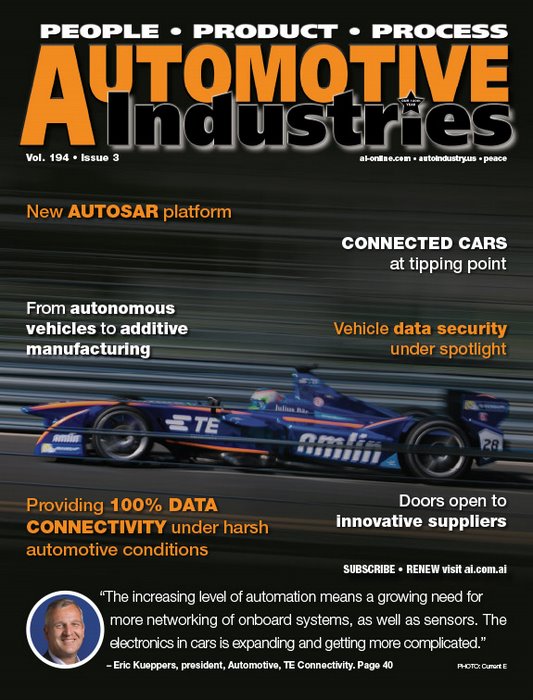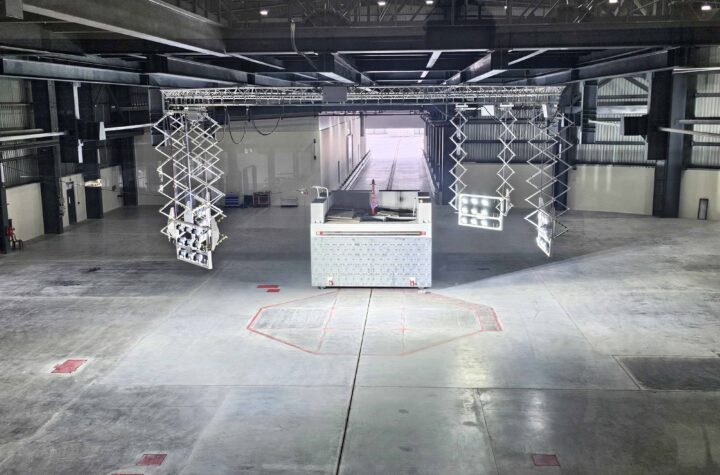
While it has not yet gained the same traction with the public as Formula 1, Formula E is helping to accelerate development in areas such as data and power connectivity, battery management, electric motor refinement, and inverter and chassis development.
More power has been added to the formula as a test bed with TE Connectivity in June 2015 being named a lead partner to Andretti Technologies, the technology incubation and advanced engineering business of Andretti Autosport. TE sponsors the Andretti Formula E Race Team, partnering on Andretti’s ATEC- 01 power train development program. The company says the technology partnership will leverage TE’s expertise in sensors and connectors, including its DEUTSCH autosport range of products, AST sensors and Raychem cables and wires.
Automotive Industries (AI) asked Eric Kueppers, president, Automotive, TE Connectivity, how autosport is contributing to the evolution of the motor car.
Kueppers: We are integral to motorsport teams around the world, and the Formula E series was created with our connectors, cables, and other parts of the wiring harness in the original design.
TE is committed to creating smart, safe, green and connected technologies, and hybrid and electric vehicles (EV) will play a major role in shaping the auto industry. Our engineering partnership with Andretti provides a platform for us both to develop and test new technologies in a racing environment to prove and promote clean energy and sustainability.
AI: What role does the company play in the connected car eco-sphere?
Kueppers: If data, power or signal moves through it, TE Connectivity connects and senses it. We provide products and solutions that drive everything from data connectivity, power and data distribution and sensing to weight reduction through miniaturization and a shift from copper to aluminum conductors. TE’s product portfolio goes well beyond connectors. We support the global automotive industry with not only high-speed power terminals and connectors, but also Ethernet and bandwidth capabilities, fiber optics, wireless antennas, and sensors that measure position, pressure and temperature, to name a few. We also provide inductive systems (coils, relays) for ABS and ESP applications, and heavy-duty relays for vehicles with electrified drives.
AI: How have the connected car and the potential of autonomous vehicles changed TE’s strategy in the auto business?
Kueppers: When connected cars eventually do become fully autonomous they are expected to be safer, while drivers will become more productive, using the time spent in the car for something other than managing traffic conditions, avoiding collisions or finding parking spaces. This increasing level of automation means a growing need for more networking of onboard systems, as well as sensors. The electronics in cars is expanding and getting more complicated.
AI: Why the industry focus on Ethernet?
Kueppers: The automotive industry needs robust and reliable connectivity solutions. Other industries already use Ethernet and transfer rates continue to increase. Our Ethernet solution includes automotive qualified components, and is designed for a harsh environment. We realize the performance of the overall system is key. So we worked closely with manufacturers, as well as chip, cable and manufacturing equipment suppliers, to develop the Ethernet solution. We also are expanding our presence in Silicon Valley to support the evolving automotive industry.
AI then asked Patrick Popp, CTO of Transportation Solutions, TE Connectivity, why the focus on harsh environment solutions for the company’s automotive business?
Popp: With the integration of so many systems into an automobile that provide increasing driver convenience and safety, our ability to provide connectivity performance 100% of the time under such harsh conditions is absolutely critical. We work with customers to develop solutions for harsh applications across a number of industries in addition to automotive. In fact, more than 80% of TE’s overall revenue comes from harsh environment applications. Our products withstand everything from high pressure, vibration and high voltage, to moisture and extreme temperature fluctuations – all of which can have an impact on a car’s performance.
AI: What technological challenges does this create?
Popp: Developing products that are reliable and withstand harsh environments is one side of the equation. Application-specific material selection and sophisticated design features become critical to meet harsh requirements such as severity Level 4 vibration class for state of the art engine applications (up to 18 g). The other side of the equation is that digital transformation is changing the vehicle’s infrastructure (for power, data and signal) as well the manufacturing and distribution processes that put this infrastructure in place.
AI: What developments have been made in sensors and/ or embedded systems?
Popp: To transport passengers safely and efficiently, vehicles need data and intelligence to process the data. So we develop and invest in a wide range of sensors and electronics-at-the-interface systems, as we expect these areas will grow disproportionately. TE acquired Measurement Specialties and American Sensor Technologies to strengthen our sensor portfolio, and acquisitions are a big part of our growth strategy. By adding electronics to an interface such as a sensing element we can help provide the data for control, adaptation and response of vehicle functions that increase safety, comfort, and efficiency.
AI asked Steve Rohr, Director of Technology Strategy, Automotive, Transportation Solutions, TE Connectivity, what is driving growth in the automotive and transport sectors.
Rohr: Industry macro-trends such as safety, the environment, and lifestyle changes are big drivers. For example, the European New Car Assessment Program is putting high importance on life-saving technologies. Autonomous driving is the industry’s answer to getting to zero fatalities. This ultimately means more connectivity and sensor solutions are required inside the vehicle because of tighter controls and more protective redundancies. As with safety, automakers working with government regulators have made tremendous strides in reducing polluting emissions from cars. The auto industry is currently working to reduce greenhouse gas emissions by 2020, with a focus on vehicle weight, fuel consumption, and improved electrical efficiency – all of which is driving the need for innovative connectivity and sensor solutions. In addition, drivers and occupants want mobility alternatives to match today’s (and tomorrow’s) lifestyle, and allow them to stay connected and recapture wasted time in traffic jams, defensive driving and looking for parking. This too requires more connectivity and sensor solutions.
AI: How closely do you work with customers when developing new technologies?
Rohr: Extremely close. Our expertise is in physical layer connectivity. We connect, protect, switch, and sense power and data. We provide solutions for the industry’s most challenging connectivity problems and needs. TE serves many industries. Odds are that a new challenge in one industry has already been solved in another industry. By leveraging “the Power of TE,” we bring expertise and solutions from many industries to our automotive customers, which is a key advantage for them. This intra-collaboration further speeds our solutions and drives even greater innovation and value for our customers. By working closely with our customers early in their product and vehicle architecture designs, we can confirm that they know “the possible” when it comes to connectivity, and continue to push forward on “the seemingly impossible” – aligning our investments with their future market needs.
www.te.com/automotive
“To transport passengers safely and efficiently, vehicles need data and intelligence to process the data.”
AI









More Stories
MESSRING completes new crash test facility for Mahindra in India
ROHM Develops an Ultra-Compact MOSFET Featuring Industry-Leading* Low ON-Resistance Ideal for Fast Charging Applications
More than 30 of the top 50 global suppliers have production facilities in Turkey